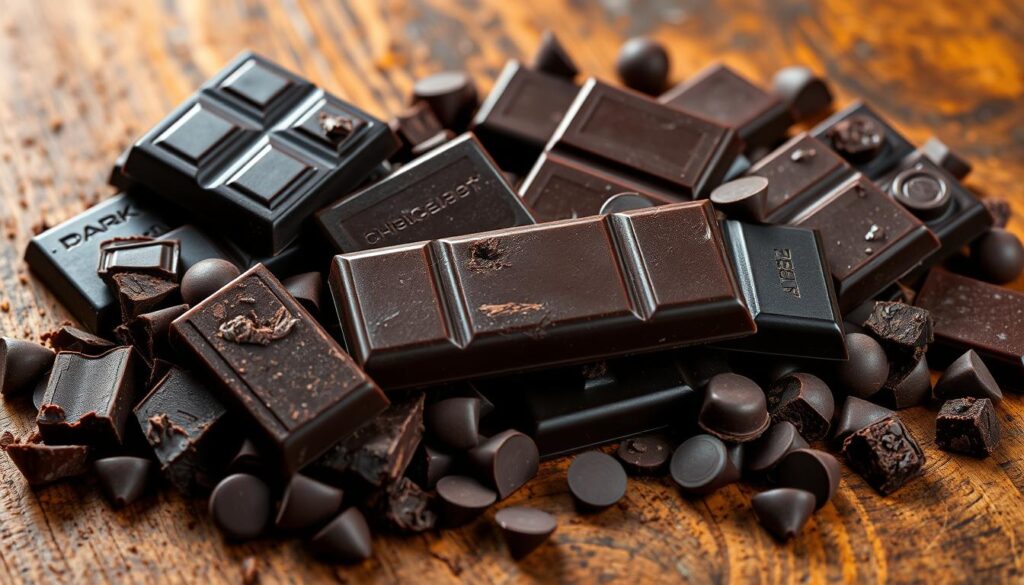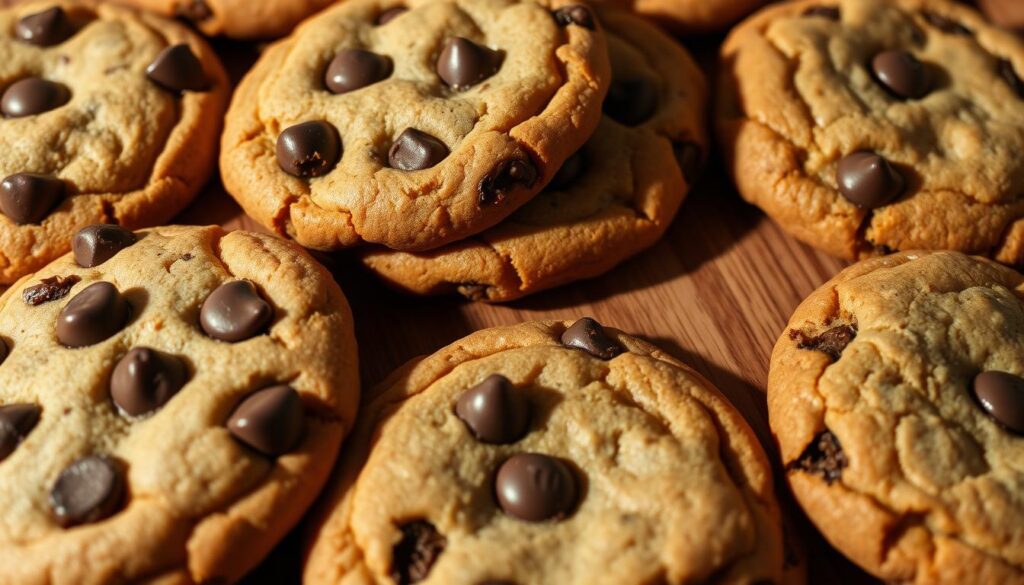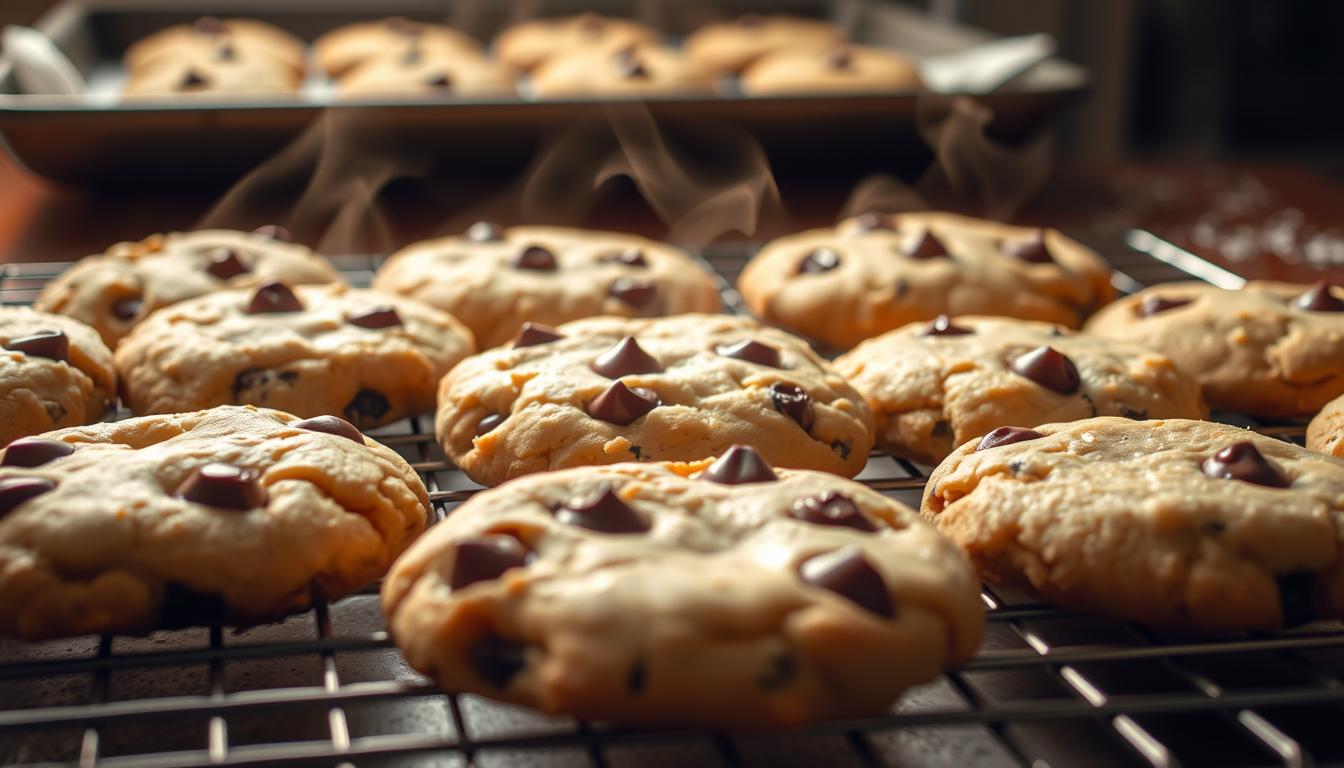Every home baker dreams of making the perfect chocolate chip cookies. These cookies bring back childhood memories. The smell of fresh cookies in your kitchen is irresistible.
Making great chocolate chip cookies is more than just a recipe. It’s an art that needs skill, quality ingredients, and passion. This guide will help you make cookies that are as good as those from a bakery.
Imagine taking out a tray of golden cookies. They have crisp edges and a soft center. The secret is knowing the science behind making these cookies, from choosing ingredients to baking them just right.
Table of Contents
Why These Are the Ultimate Chocolate Chip Cookies
Making the perfect homemade desserts is more than just mixing ingredients. These chocolate chip cookies are the best, blending expert bakery skills with home cooking magic.
The secret is in the art of cookie making. Each batch offers a special culinary adventure. It turns simple ingredients into amazing treats.
Rich Butterscotch Flavor Profile
Your taste buds will love the deep, complex flavor. It comes from special ingredients. The rich butterscotch taste comes from:
- Dark brown sugar with high molasses content
- High-quality unsalted butter
- Natural vanilla extract
Perfectly Balanced Texture
Getting the perfect cookie texture is a science. These desserts have a magical mix of:
- Crispy, golden-brown edges
- Soft, chewy center
- Substantial chocolate distribution
Professional Bakery Quality at Home
Turn your kitchen into a gourmet bakery with special techniques. Precision is key:
| Technique | Impact |
|---|---|
| Precise ingredient measurement | Consistent flavor and texture |
| Controlled butter temperature | Enhanced flavor development |
| Strategic chilling | Deeper flavor complexity |
“Baking is love made edible” – Unknown Pastry Chef
Mastering these techniques lets you make cookies as good as those from a bakery. And you can do it right in your kitchen.
Essential Ingredients for Perfect Chocolate Chip Cookies
Creating classic treats like chocolate chip cookies starts with understanding the magic of each ingredient. Your baking recipes will shine when you select high-quality components. These components transform simple ingredients into extraordinary cookies.
Butter is the foundation of rich, butterscotch flavor. Not all butter is created equal – choose unsalted, high-quality butter. This helps control salt levels and enhances taste. At room temperature, butter blends seamlessly, creating a smooth cookie dough.
- Unsalted butter (8 tablespoons)
- White sugar (1/2 cup)
- Light brown sugar (1/4 cup)
- Pure vanilla extract (1 teaspoon)
- Large egg (1)
- All-purpose flour (1 1/2 cups)
- Baking soda (1/2 teaspoon)
- Salt (1/4 teaspoon)
- Chocolate chips/chunks (3/4 cup)
Sugar is key in your baking recipes. A mix of white and brown sugar adds depth of flavor. Dark brown sugar adds moisture and a subtle molasses note, elevating the cookies.
“The secret to exceptional cookies lies in the quality of your ingredients”
Vanilla extract brings complexity to your chocolate chip cookies. Choose pure vanilla extract for a more authentic, rich flavor. Your chocolate selection matters too – dark chocolate chunks melt more luxuriously. They create pockets of intense chocolate in every bite.
The Science Behind Cookie Chemistry
Baking the perfect chocolate chip cookies is more than just mixing ingredients. It’s a delicate science that turns simple parts into tasty treats. Knowing the chemical interactions can make your baking go from good to amazing.
Let’s explore the fascinating world of cookie chemistry. We’ll uncover the secrets that make chocolate chip cookies truly special.
Sugar-to-Butter Ratio: The Flavor Foundation
The sugar and butter mix is key for the perfect cookie texture. Your butter should be about 80% fat, adding richness and flavor. When you cream butter and sugar, you add air bubbles that can grow up to 30% when baked.
- White sugar creates crisp edges
- Brown sugar adds moisture and softness
- Proper ratio ensures ideal spread and texture
Baking Soda: The Leavening Marvel
Baking soda is a powerful ingredient in chocolate chip cookies. It needs an acid to work, which brown sugar’s molasses provides. This mix creates tiny bubbles, making the cookies tender and soft.
Brown Sugar’s Magic Touch
Brown sugar does more than sweeten. Its molasses add about 7% more moisture than white sugar. This extra moisture makes the cookies softer and chewier, staying moist and delicious.
“Baking is a science, and cookies are the delicious experiment!” – Professional Baker
By grasping these scientific principles, you’ll make your baking recipes into top-notch chocolate chip cookies. Everyone will love them.
Secret Tips for Bakery-Style Results
Want to make your homemade desserts stand out? Professional baker’s secrets can help. With a few insider tips, your buttery sweets can become truly special.
Professional bakers say small ingredients can make a big difference. Adding a bit of honey or corn syrup to your dough is a game-changer. These ingredients keep your cookies moist and chewy.
“The difference between good and great cookies is often just one unexpected ingredient.”
- Use room temperature ingredients for smoother mixing
- Invest in a kitchen scale for precise measurements
- Incorporate corn syrup or honey for enhanced moisture
- Control ingredient temperatures carefully
Temperature is key when making buttery sweets. Your butter should be soft, eggs room temperature, and ingredients measured right. A kitchen scale helps ensure your desserts are always perfect.
Professional bakers see cookie making as a science. Each ingredient affects the cookie’s texture, taste, and look. Paying attention to these details will make your cookies as good as any bakery’s.
Measuring and Mixing Techniques
Mastering baking recipes is all about precision, like making perfect chocolate chip cookies. The right way to measure and mix can turn your homemade treats into something special.
Precise Flour Measurement
Getting the flour right is key for your chocolate chip cookies. Professional bakers suggest:
- Using a kitchen scale for exact measurements
- Aiming for 170 grams of flour per cup
- Utilizing the spoon and level method
“Precision in measurement is the secret to bakery-quality cookies”
Butter Temperature Mastery
Butter at room temperature is essential for perfect cookies. It creams better and makes the cookies light and fluffy.
Strategic Mixing Techniques
The way you mix ingredients affects your cookie’s texture. Here are some tips:
- Cream butter and sugar until pale and fluffy
- Mix dry ingredients separately
- Avoid overmixing after adding flour
By using these precise measuring and mixing methods, you’ll improve your baking. Your chocolate chip cookies will be as good as those from a professional bakery.
The Role of Dark Chocolate Selection
Making classic treats like homemade desserts needs careful chocolate picking. Dark chocolate turns simple cookies into amazing dishes. Choosing the right chocolate is key to making the perfect chocolate chip cookie.

Experts say to use chocolate bars instead of chips. Chocolate bars have more cocoa butter, which melts better and makes cookies richer.
“The secret to exceptional cookies lies in the quality of chocolate you choose.” – Pastry Chef Recommendation
- 60-70% cocoa content provides perfect balance
- Chunk chocolate creates gooier, more indulgent bites
- Premium dark chocolate enhances overall cookie texture
When picking chocolate for your homemade desserts, keep these points in mind:
| Chocolate Type | Cocoa Percentage | Flavor Profile |
|---|---|---|
| Bittersweet | 60-70% | Intense, complex flavor |
| Semisweet | 35-60% | Balanced, mild sweetness |
| Milk Chocolate | 10-30% | Creamy, sweeter profile |
Pro tip: Hand-chop chocolate bars for uneven chunks that create delightful melting pockets in your cookies. This trick makes your classic treats go from good to amazing. It ensures every bite is full of chocolate joy.
Chilling Time: Why Patience Matters
Perfecting chocolate chip cookies is more than just using the right ingredients. It’s also about the technique. Chilling the dough is a key step that turns good cookies into amazing ones.
Professional bakers know that patience is key to success. Chilling the dough is not just a tip—it’s a must for making cookies that taste like they came from a bakery.
Temperature Effects on Texture
Cold temperatures change how cookies turn out. Chilling the dough leads to several benefits:
- Butter gets firmer, making cookies less spread out
- Flour absorbs moisture better
- Gluten development is less
- Dough is easier to work with
Flavor Development During Rest
Chilling the dough does more than just improve texture. It also enhances flavor. The longer it rests, the more ingredients blend together, creating richer tastes.
| Chilling Duration | Texture Impact | Flavor Development |
|---|---|---|
| 30 minutes | Firmer dough | Initial flavor blending |
| 24-48 hours | Optimal texture | Rich, complex flavors |
“Good things come to those who wait—specialy in baking.”
When baking your next batch of chocolate chip cookies, remember chilling is not just a step. It’s the secret to making them perfect, just like from a bakery.
Baking Temperature and Timing Mastery
Creating perfect homemade desserts needs precise baking skills. These skills turn simple ingredients into amazing chocolate chip cookies. The key is controlling the temperature to get bakery-quality results at home.
Your oven’s temperature greatly affects the cookie’s texture and taste. Here are key tips for baking the best batch:
- Standard baking temperature: 350°F
- Baking time: 10-12 minutes
- Ideal doneness: Light golden edges, soft centers
Experts say to use an oven thermometer for accuracy. Even a small temperature difference can make your cookies go from perfect to burnt.
“Baking is a science where precision meets creativity” – Professional Baker’s Wisdom
Different temperatures lead to different cookie textures:
| Temperature | Cookie Texture Result |
|---|---|
| 325°F | Softer, more moisture-rich cookies |
| 350°F | Classic crisp edges, soft center |
| 375°F | Crispier, more caramelized edges |
After baking, let your cookies rest on the sheet for 10 minutes. This step is crucial. It helps the cookies cook fully, making them crisp on the outside and soft inside.
Understanding Cookie Spread and Texture
Making the perfect chocolate chip cookies is all about how you bake them. The spread and texture of your treats depend on key factors. These can turn an ordinary cookie into a masterpiece.

Getting the right spread in chocolate chip cookies can be hard. The texture of your cookies comes from many things that happen while they are baked.
Edge Caramelization Magic
The edges of your cookies show a story of heat and sugar. As heat rises, sugar breaks down. This creates a golden-brown edge that makes your treats more interesting.
- Butter temperature affects caramelization speed
- Sugar type impacts edge coloration
- Oven temperature determines caramelization intensity
Controlling Center Softness
To get that perfect gooey center, you need to be precise. If your cookies aren’t spreading right, try these tips:
- Press cookie dough lightly before baking
- Ensure ingredients are at room temperature
- Experiment with small test batches
“The secret to great chocolate chip cookies is understanding how ingredients interact at different temperatures.” – Baking Expert
Creating amazing chocolate chip cookies is both science and art. Your patience and focus will make treats that everyone will adore.
Storage Tips for Maximum Freshness
Keeping your homemade desserts fresh is key. Your buttery sweets need careful storage to stay delicious. This helps keep their taste and texture just right.
For short-term enjoyment, room-temperature storage is best. Here are some important tips:
- Store cookies in an airtight container
- Keep at room temperature for up to 3 days
- Place a slice of bread in the container to maintain moisture
Pro tip: Separate soft and crisp cookies to prevent texture transfer.
Freezing is the way to go for longer storage. Wrap each cookie in plastic wrap or aluminum foil. Then, store them in a freezer-safe container. This way, your desserts can stay fresh for up to two months.
“The secret to great cookies is not just in baking, but in storing them right!” – Baking Enthusiast
Want to make your stored cookies taste like they just came out of the oven? Try these easy tips:
- Microwave for 5-10 seconds
- Warm in a 300°F oven for 3-5 minutes
- Let frozen cookies thaw at room temperature
With these storage tips, your buttery sweets will always taste like they were just baked!
Common Baking Mistakes to Avoid
Baking perfect chocolate chip cookies needs precision and care. Many home bakers face frustrating challenges. These can turn their baking into disappointments. Knowing common mistakes helps make bakery-quality cookies every time.
Ingredient Measurement Mishaps
Precision is crucial in baking. About 50% of failures come from wrong ingredient measurements. Here are key errors to avoid:
- Using unsifted flour can make cookies dense and thick
- Not leveling dry ingredients can upset the recipe balance
- Incorrect butter temperature greatly affects cookie texture
Mixing and Temperature Challenges
How you mix ingredients greatly affects your cookies’ texture. Overmixing can make cookies tough. Pro tip: Mix just until the ingredients are combined.
“Baking is a science, and precision matters more than creativity.” – Professional Baker’s Wisdom
Baking Sheet and Oven Considerations
The baking sheet you use can greatly affect your cookies. Dark sheets can raise baking temperatures by 10-15°F, risking burns. Always use light-colored sheets and consider an oven thermometer for accuracy.
Spread and Texture Control
Cookie spread is a common issue. Key factors include:
- Dough temperature (chilled dough spreads less)
- Sugar ratio (brown sugar helps control spread)
- Butter consistency
By understanding these pitfalls, you’ll make irresistible chocolate chip cookies. They’ll rival those from professional bakeries.
Conclusion
Mastering homemade desserts like chocolate chip cookies takes passion, precision, and practice. You’ve learned the key skills to make treats as good as those from a bakery. Your cookie science journey has turned simple baking into a special culinary experience.
The art of baking classic treats is more than just following a recipe. It’s about understanding the balance of ingredients and techniques. Whether you choose 60% cacao semisweet or 70% bittersweet chocolate, you can make cookies that are as good as those from a professional bakery. Remember, bakers like Claire Saffitz spent 40 test batches perfecting their recipes.
With nearly 30 different cookie flavors and techniques, your baking possibilities are endless. Each batch connects you to a long culinary tradition that started with Ruth Wakefield’s accidental invention at the Toll House Inn. Embrace the learning process, experiment boldly, and enjoy the delicious results of your baking adventure.
Your next batch of chocolate chip cookies is waiting—so preheat that oven and let your newfound skills shine. The journey from amateur baker to cookie maestro starts now!


1 thought on “The Best Chocolate Chip Cookies You’ll Ever Bake”